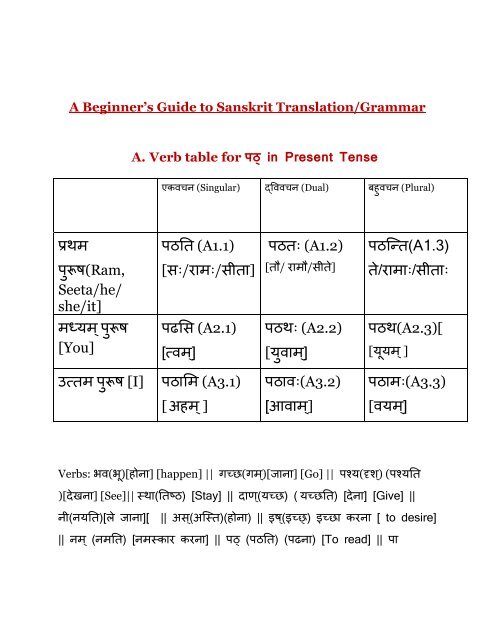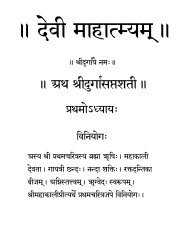You also want an ePaper? Increase the reach of your titles
YUMPU automatically turns print PDFs into web optimized ePapers that Google loves.
A Beginner’s Guide to Sanskrit Translation/Grammar<br />
(Ram,<br />
Seeta/he/<br />
she/it]<br />
[You]<br />
A. Verb table for in Present Tense<br />
एकवचन (Singular) ववचन (Dual) वचन (Plural)<br />
(A1.1)<br />
[ / / ]<br />
[ व<br />
(A2.1)<br />
[I] (A3.1)<br />
[<br />
]<br />
]<br />
(A1.2)<br />
[ / / ]<br />
[ व<br />
(A2.2)<br />
]<br />
व (A3.2)<br />
[ व ]<br />
Verbs: भव(भ )[ न ] [happen] || ( )[ न ] [Go] || ( ) (<br />
[<br />
/ /<br />
)[ न ] [See]|| ( ) [Stay] || ( ) ( ) [ न ] [Give] ||<br />
[व<br />
(A1.3)<br />
(A2.3)[<br />
]<br />
]<br />
(A3.3)<br />
न (न )[ न ][ || ( )( न ) || ( ) क न [ to desire]<br />
|| न (न ) [न क क न ] || ( ) ( न ) [To read] ||
( )( न ) [To Drink] || ( ) [Wins] || न (न ) न चन<br />
[Dance] || ( न ) [Laugh] || व (व ) ( न ) [Speak] etc<br />
1. Noun Table of ( )<br />
एकवचन<br />
(Singular)<br />
व क<br />
ववचन (Dual) वचन (Plural)<br />
क (1.1.a) क (1.1.b) क (1.1.c)<br />
क (1.2.a) क (1.2.b) क न (1.2.c)<br />
क न (1.3.a) क<br />
क (1.4.a) क<br />
(1.5.a) क<br />
(1.3.b) क (1.3.c)<br />
(1.4.b) क (1.4.c)<br />
(1.5.b) क (1.5.c)<br />
क (1.6.a) क (1.6.b) क न<br />
क (1.7.a) क ( 1.7.b) क (1.7.c)<br />
(1.6.c)<br />
क (1.8.a) क (1.8.b) क (1.8.c)<br />
� Noun table of न न भ क क व भ<br />
न क व व च नक व व व<br />
भ etc will follow exactly same as क
2. Noun Table of , [Feminine]<br />
एकवचन<br />
(Singular)<br />
ववचन (Dual) वचन (Plural)<br />
(2.1.a) (2.1.b) (2.1.c)<br />
(2.2.a) (2.2.b) (2.2.c)<br />
(2.3.a)<br />
(2.4.a)<br />
(2.5.a)<br />
(2.3.b)<br />
(2.4.b)<br />
(2.5.b)<br />
(2.6.a) (2.6.b) न<br />
भ (2.3.c)<br />
(2.4.c)<br />
(2.5.c)<br />
(2.6.c)<br />
(2.7.a) (2.7.b) (2.7.c)<br />
(2. 8. a) (2.8.b) (2.8.c)<br />
� Noun table of न क न क क<br />
भ व क etc will follow this form.
3. Noun Table for फ [ Fruits] [Neuter<br />
एकवचन<br />
(Singular)<br />
Gender]<br />
ववचन (Dual) वचन (Plural)<br />
( 3.1.a) (3.1.b) न (3.1.c)<br />
(3.2.a) (3.2.b) न (3.2.c)<br />
न (3.3.a)<br />
(3.4.a)<br />
(3.5.a)<br />
(3.3.b)<br />
(3.4.b)<br />
(3.5.b)<br />
(3.6.a) (3.6.b) न<br />
(3.3.c)<br />
(3.4.c)<br />
(3.5.c)<br />
(3.6.c)<br />
(3.7.a) (3.7.b) (3.7.b)<br />
(3.8.a) (3.8.b) न (3.8.c)<br />
� Noun table of words like , , , न , , क, , , ,<br />
, etc will follow table. They all are of neuter gender.
4. Non table for [ ] [ I ]<br />
एकवचन (Singular) ववचन (Dual) वचन (Plural)<br />
(4.1.a) व<br />
(4.2.a) व<br />
(4.3.a) व<br />
(4.4.a) व<br />
(4.5.a) व<br />
(4.1.b) व<br />
(4.1.c)<br />
(4.2.b) न (4.2.c)<br />
(4.3.b) भ (4.3.c)<br />
(4.4.b)<br />
(4.5.b)<br />
(4.6.a) व (4.6.b) क<br />
(4.4.c)<br />
(4.5.c)<br />
(4.6.c)<br />
(4.7.a) व (4.7.b) (4.7.c)<br />
5. Noun table for [ ] [You]<br />
एकवचन (Singular) ववचन (Dual) वचन (Plural)<br />
व<br />
व<br />
(5.1.a) व<br />
(5.2.a)<br />
व (5.3.a) व<br />
व<br />
(5.4.a) व<br />
(5.5.a) व<br />
(5.1.b)<br />
(5.1.c)<br />
(5.2.b) न (5.2.c)<br />
(5.3.b) भ (5.3.c)<br />
(5.4.b)<br />
(5.5.b)<br />
व (5.6.a) व (5.6.b) क<br />
(5.4.c)<br />
(5.5.c)<br />
(5.6.c)<br />
व (5.7.a) व (5.7.b) (5.7.c)
6. Noun Table for<br />
ह [He]<br />
एकवचन (Singular) ववचन (Dual) वचन (Plural)<br />
(6.1.a) (6.1.b) (6.1.c)<br />
(6.2.a) (6.2.b) न (6.2.c)<br />
न (6.3.a)<br />
(6.4.a)<br />
(6.5.a)<br />
(6.3.b) (6.3.c)<br />
(6.4.b) (6.4.c)<br />
(6.5.b) (6.5.c)<br />
(6.6.a) (6.6.b) (6.6.c)<br />
न (6.7.a) (6.7.b) (6.7.c)<br />
7. Noun Table for<br />
ह [She]<br />
एकवचन (Singular) ववचन (Dual) वचन (Plural)<br />
(7.1.a) (7.1.b) (7.1.c)<br />
(7.2.a) (7.2.b) (7.2.c)<br />
(7.3.a)<br />
(7.4.a)<br />
(7.5.a)<br />
(7.3.b) भ (7.3.c)<br />
(7.4.b) (7.4.c)<br />
(7.5.b) (7.5.c)<br />
(7.6.a) (7.6.b) (7.6.c)<br />
(7.7.a) (7.7.b) (7.7.c)
Prathama Vibhakti : Who is doing the work? Always ask who? Of<br />
course it’s the subject, the doer. So, use first form, Nominative case with the noun, i.e:<br />
Prathama Vibhakti<br />
� Ram goes. [ 1.1.a] [A1.1]Who goes? Rama: Hence<br />
Nominative case & Prathama Vibhakti<br />
� Sita goes. [2.1.a] [A1.1]<br />
� He Goes. [6.1.a] [A1.1]<br />
� She goes. [7.1.a] [A1.1]<br />
� Boy goes: क [1.1.a] [A1.1]<br />
� Two boys go. क [1.1.b] [A1.2]<br />
� Many boys go. क [1.1.c] [A1.3]<br />
Dwitiya Vibhakti: This is accusative case or the objective case. If you<br />
ask what or where in the sentence, you will have to use Dwitiya Vibhakti. For example:<br />
What does Ram see? [A book] Where does he go? [To home] What does he read? [A<br />
book] etc<br />
� Ram goes to home : [1.1.a] [3.2.a] [A1.1]<br />
� Ram reads book. [1.1.a] क [3.2.a] [A1.1]<br />
� Boy eats an apple. क [1.1.a] [3.2.a] [A1.1]<br />
� Two boys eat an apple. क [1.1.b] [3.2.a] [A1.2]<br />
� Many boys eat an apple. क [1.1.c] [3.2.a] [[A1.3]<br />
� Many boys eat many apples. क [1.1.c] न[3.2.c] [A1.3]
Tritiya Vibhakti: In Tritiya Vibhakti or Dative case, always ask, how<br />
does one do the action. For example: How does one see books? Answer: With eyes. It is<br />
called instrumental case. It is used when the instrument that helps noun do the verb<br />
comes into action. Like, in this case: It’s the eyes, the instrument that helps the subject,<br />
“He” do the action:-See.<br />
� Rama reads a book with an eye. [1.1.a] न [3.3.a] क [3.2.a] [A1.a]<br />
� Ram reads the book with both eyes. [1.1.a] न [3.3.b] क [3.2.a]<br />
[A1.1]<br />
� Sita plays with ball. [2.1.a] क क न[3.3.a] [A1.1]<br />
� He comes by airplane. [6.1.a] व न न [3.3.a] [A1.1]<br />
� He eats with mouth. [6.1.a] न [3.3.a] [A1.1]<br />
N.B: Alaways ask, How does Rama read? With eyes, hence न [3 rd form], How does<br />
Sita play? With ball, hence क क न [3 rd form]. How does he come? With airplane,<br />
hence व न न [3 rd form]. How does he eat? With mouth, hence 3 rd form न<br />
Chaturthi Vibhakti: In Chaturthi Vibhakti, always ask the purpose.<br />
Why does one read? What is the purpose of reading? Why is he running? So, with the<br />
answer that you get, use Chaturthi Vibhakti.<br />
� He reads a book for money. [6.1.a] [3.4.a] [A1.1]<br />
� Monkey jumps for fruits. व न [1.1.a] [3.4.a] क [A1.1]<br />
� He runs for home. [6.1.a] [3.4.a] [A1.1]<br />
Panchami Vibhakti; In Panchami Vibhakti or Dative case, always ask,<br />
from where? Look at the examples: Fruit falls from tree. He comes from home.<br />
� He comes from home. [6.1.a]<br />
[3.5.a] [A1.1]
� Fruit falls from tree.<br />
[3.1.a] व [3.5.a] [A1.1]<br />
Shashthi Vibhakti: In Shashthi Vibhakti or Genitive case, always ask,<br />
“Whose”? For example, whose book is this? This is Ram’s book.<br />
� He goes to Ram’s home. [6.1.a] [1.6.a] [3.2.a] [A1.1]<br />
� Ram is Dasharatha’s son. [1.1.a] [1.6.a] [1.1.a] [A1.1]<br />
Saptami Vibhakti: Saptami Vibhakti or Locative case is used for<br />
situations where you say, “In house, on house, on the table, over the head” etc. For<br />
example: He lives in the house. So for “in the house” we need to look for Saptami<br />
Vibhakti of the noun table.<br />
� He lives in the house. [6.1.a] [1.7.a] व [A1.1]<br />
Ram lives in people’s heart. [1.1.a] न न [3.6.c] [3.7.a] व [1.1.a]
8. Noun Table for [ ह] [ ] [This/It]<br />
एकवचन (Singular) ववचन (Dual) वचन (Plural)<br />
(8.1.a) ए (8.1.b) (8.1.c)<br />
(8.2.a) (8.2.b) न (8.2.c)<br />
न न (8.3.a)<br />
(8.4.a)<br />
(8.5.a)<br />
(8.3.b) ए भ (8.3.c)<br />
(8.4.b) ए (8.4.c)<br />
(8.5.b) ए (8.5.c)<br />
(8.6.a) न (8.6.b) ए (8.6.c)<br />
न (8.7.a) न (8.7.b) ए (8.7.c)<br />
9. Noun Table for [ ह] [ ] [ This/It] [Feminine]<br />
एकवचन (Singular) ववचन (Dual) वचन (Plural)<br />
(9.1.a) (9.1.b) (9.1.c)<br />
(9.2.a) (9.2.b) (9.2.c)<br />
न (9.3.a)<br />
(9.4.a)<br />
(9.5.a)<br />
(9.3.b) भ (9.3.c)<br />
(9.4.b) (9.4.c)<br />
(9.5.b) (9.5.c)<br />
(9.6.a) न (9.6.b) (9.6.c)<br />
(9.7.a) न (9.7.b) (9.7.c)
P.S: We will add more and more sentences with more and<br />
more examples as and when we get time. The coding system<br />
that I have adopted is unique and cannot be found out in any<br />
other textbooks. More about the coding system will be<br />
updated soon. Questions are welcome. Hope you enjoy<br />
learning Sanskrit<br />
~Mother India Team<br />
[Doc Prepared by Mihir]




